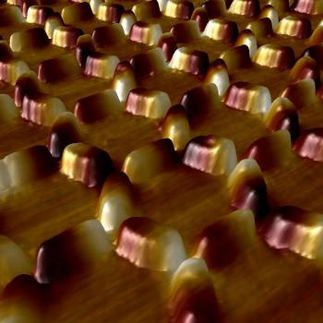Freezing magnetic monopoles
How dipoles become monopoles and vice versa
Advertisement
magnetic monopoles, entities with isolated north or south magnetic poles, weren't supposed to exist. If you try to saw a bar magnet in half, all you succeed in getting are two magnets, each with a south and north pole. In recent years, however, the existence of monopoles, at least in the form of "quasiparticles" consisting of collective excitations among many atoms, has been predicted and demonstrated in the lab. Now Stephen Powell, a scientist at the Joint Quantum Institute (JQI) and the University of Maryland, has sharpened the theoretical framework under which monopoles can operate.
"Steady flows of magnetic monopoles are apparently impossible," Powell said, "but transient currents have been demonstrated, and one could imagine creating an alternating current, the magnetic equivalent of AC electricity." This so-called 'magnetricity' might be exploited for designing new kinds of high-density data storage.
The laws of electromagnetism predict a great symmetry between electric and magnetic forces. This equality does not extend, however, to isolated magnetic "charges." Isolated electric charges, in the form of electrons, are of course quite common. Such charges attract or repel each other with a force inversely proportional to the square of the distance between the charges. A positive charge and a negative charge can team up to form a neutral electric dipole. The situation in magnetism seems different: dipoles yes, monopoles no.
But new ideas and new experiments have changed the conventional thinking. First, experiments with cold electrons flowing in a two-dimensional sheet could, under the action of powerful magnetic fields, be coaxed into moving in circular orbits. These orbits in turn seem to interact to produce quasiparticles which have a charge equal to a fraction of the conventional electron charge. This was called the fractional quantum Hall effect. Could there be an analog for magnetic dipoles? Could circumstances allow the existence of isolated (or fractional) magnetic poles?
Recent experiments and Germany and France point to this possibility in so called "spin ice," a solid material made of the elements dysprosium (Dy), titanium (Ti), and oxygen (O). The basic building block of these materials is a pair of tetrahedral groupings, with (typically) two Dy atoms (each of which acts like a tiny dipole magnet of its own) pointing out of each tetrahedron and two pointing in. This is analogous to the orientation of hydrogen atoms in water ice, hence the name "spin ice."
Normally all magnetic poles should be confined within two-pole couplets---the traditional magnetic dipole. However, at a low enough temperature, around 5 K, "frustration" among the magnetic atoms---they want to align with each other but can't because of the inherent geometry of the material---leads to a disordered state with strong, synchronized fluctuations. Unpaired magnetic poles can form amid this tumult. That is, particles (quasiparticle excitations, to be exact) in spin ice with a net magnetic "charge" can exist and move about. A gas of electric charges is called a "plasma," so some scientists refer to the analogous tenuous cloud of magnetic charges as a "monopole plasma."
Stephen Powell's paper, published in the journal Physical Review Letters, explores what happens when the fluctuations are frozen by, for example, still-colder temperatures or a high-strength magnetic field. He shows how the monopoles are confined into magnetically neutral dipoles again. He is the first to prescribe the phase transition from the monopole phase (also called the Coulomb phase since the monopoles feel the same inverse-square force effect as electric charges) into the pole-confined phase.
Going to those lower temperatures, and observing how monopoles freeze into dipoles, will be difficult to achieve in the lab since it is hard to coax the magnetic atoms into interacting strongly enough. But Powell thinks it can be done. Furthermore, if this transition were like other phase transitions, then it should be subject to a body of laws called "universality," which typify many such phenomena---water turning into ice is a favorite example. Powell is the first to address how universality pertains to the freezing process, when monopoles in spin ice lapse back into dipoles at super-low temperatures.
"These kinds of magnetic monopoles are not just mathematical abstractions," said Powell. "They really appear. They can move around, at least a little bit. Scientists need to understand how monopoles behave, even at the lowest temperatures where they get locked back into dipoles." Powell's framework for monopoles includes testable predictions about how to observe the transition from monopoles into confined poles.
Original publication
"Universal monopole scaling near transitions from the Coulomb phase,"; Physical Review Letters 109, 065701 (2012)


































































